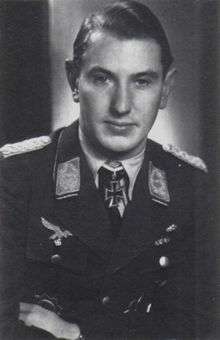Walter Borchers
| Walter Borchers | |
|---|---|
 Walter Borchers | |
| Born |
22 January 1916 Ofen, Ammerland, Duchy of Oldenburg |
| Died |
6 March 1945 (aged 29) north of Altenburg |
| Allegiance |
|
| Service/branch |
|
| Rank | Oberstleutnant |
| Unit | ZG 76, NJG 1, NJG 2 |
| Commands held | III./NJG 5, NJG 5 |
| Battles/wars | |
| Awards | Knight's Cross of the Iron Cross |
| Relations |
Adolf Borchers (brother) Hermann Borchers (brother) |
Walter Borchers (22 January 1916 – 6 March 1945) was a Luftwaffe night fighter flying ace of World War II. Borchers was credited with 59 aerial victories, including 43 nocturnal victories, 10 as a destroyer pilot and 6 four-engined bombers at day time, claimed in roughly 300 combat missions.[1][Notes 1] A flying ace or fighter ace is a military aviator credited with shooting down five or more enemy aircraft during aerial combat.[2] Prior to his death he held the service position Geschwaderkommodore (wing commander) of the night fighter wing Nachtjagdgeschwader 5.
Biography
Walter Borchers was born on 22 January 1916 in Ofen in Ammerland, Duchy of Oldenburg as the third of three brothers. All of whom would be awarded the Knight’s Cross of the Iron Cross during the course of World War II. His brother, Major Adolf Borchers received the Knight's Cross on 22 November 1944 as Staffelkapitän of 11./Jagdgeschwader 51 "Mölders". A second brother, SS-Hauptsturmführer Hermann Borchers received the Knight's Cross on 16 October 1944 as commander of the I. Battalion of the SS-Panzergrenadier-Regiment 19.[3]
Borchers was a member of the 5th Staffel (squadron) of Zerstörergeschwader 76 (ZG 76) at the outbreak of World War II on 1 September 1939.[Notes 2] He became the Staffelkapitän of 5./ZG 76 in the fall of 1940. He claimed 10 aerial victories during the Battle of France and Battle of Britain.[1]
His Staffel was transformed to the 8./Nachtjagdgeschwader 3 (NJG 3) in the fall of 1941, flying night fighter missions in Defence of the Reich. Borchers claimed his first nocturnal aerial victory on the night of 3 March 1943. He claimed his 12th and 15th against the United States Army Air Forces (USAAF) heavies—four-engined strategic bombers—in 1943. Still an Oberleutnant he was made Gruppenkommandeur of the III./Nachtjagdgeschwader 5 (NJG 5) on 22 April 1943, leading the Gruppe (group) until 23 March 1944. In this position he claimed a further six nocturnal victories and four heavy USAAF bombers shot down. He was promoted to Major and took command of NJG 5 as Geschwaderkommodore. He received the Knight's Cross of the Iron Cross on 29 October 1944 by which time he had achieved 45 aerial victories in total.[1]
Having claimed an Avro Lancaster, Borchers was shot down and killed in action on the night of 6 March 1945 by a long-range British night fighter north of Altenburg. Flying Junkers Ju 88 G-6 "C9+GA" (Werknummer 622 319—factory number) his air gunner parachuted to safety while his radio operator Leutnant Friedrich Reul was also killed. Borchers had been nominated for the Oak Leaves to the Knight's Cross which he never received.[1] His victor was Wing Commander Walter Gibb and Flying Officer Kendall of No 239 Squadron, Royal Air Force (RAF), part of No. 100 Group RAF, flying a de Havilland Mosquito night fighter.[4]
Awards
- German Cross in Gold on 12 July 1943 as Oberleutnant in the 8./NJG 3[5]
- Knight's Cross of the Iron Cross on 29 October 1944 as Major and Gruppenkommandeur of the III./NJG 5[6]
Notes
- ↑ For a list of Luftwaffe night fighter aces see List of German World War II night fighter aces
- ↑ For an explanation of the meaning of Luftwaffe unit designation see Organization of the Luftwaffe during World War II.
References
Citations
Bibliography
- Bowman, Martin W. (1998). Mosquito Fighter/Fighter-Bomber Units of World War 2. Osprey Publishing. ISBN 1-85532-731-7.
- Fellgiebel, Walther-Peer (2000) [1986]. Die Träger des Ritterkreuzes des Eisernen Kreuzes 1939–1945 — Die Inhaber der höchsten Auszeichnung des Zweiten Weltkrieges aller Wehrmachtteile [The Bearers of the Knight's Cross of the Iron Cross 1939–1945 — The Owners of the Highest Award of the Second World War of all Wehrmacht Branches] (in German). Friedberg, Germany: Podzun-Pallas. ISBN 978-3-7909-0284-6.
- Obermaier, Ernst (1989). Die Ritterkreuzträger der Luftwaffe Jagdflieger 1939 – 1945 [The Knight's Cross Bearers of the Luftwaffe Fighter Force 1939 – 1945] (in German). Mainz, Germany: Verlag Dieter Hoffmann. ISBN 978-3-87341-065-7.
- Patzwall, Klaus D.; Scherzer, Veit (2001). Das Deutsche Kreuz 1941 – 1945 Geschichte und Inhaber Band II [The German Cross 1941 – 1945 History and Recipients Volume 2] (in German). Norderstedt, Germany: Verlag Klaus D. Patzwall. ISBN 978-3-931533-45-8.
- Scherzer, Veit (2007). Die Ritterkreuzträger 1939–1945 Die Inhaber des Ritterkreuzes des Eisernen Kreuzes 1939 von Heer, Luftwaffe, Kriegsmarine, Waffen-SS, Volkssturm sowie mit Deutschland verbündeter Streitkräfte nach den Unterlagen des Bundesarchives [The Knight's Cross Bearers 1939–1945 The Holders of the Knight's Cross of the Iron Cross 1939 by Army, Air Force, Navy, Waffen-SS, Volkssturm and Allied Forces with Germany According to the Documents of the Federal Archives] (in German). Jena, Germany: Scherzers Militaer-Verlag. ISBN 978-3-938845-17-2.
- Scutts, Jerry (1998). German Night Fighter Aces of World War 2. Osprey Publishing. ISBN 1-85532-696-5.
- Spick, Mike (1996). Luftwaffe Fighter Aces. New York: Ivy Books. ISBN 978-0-8041-1696-1.
| Military offices | ||
|---|---|---|
| Preceded by Major Egmont Prinz zur Lippe-Weißenfeld |
Commander of Nachtjagdgeschwader 5 15 March 1944 – 5 March 1945 |
Succeeded by Major Rudolf Schoenert |